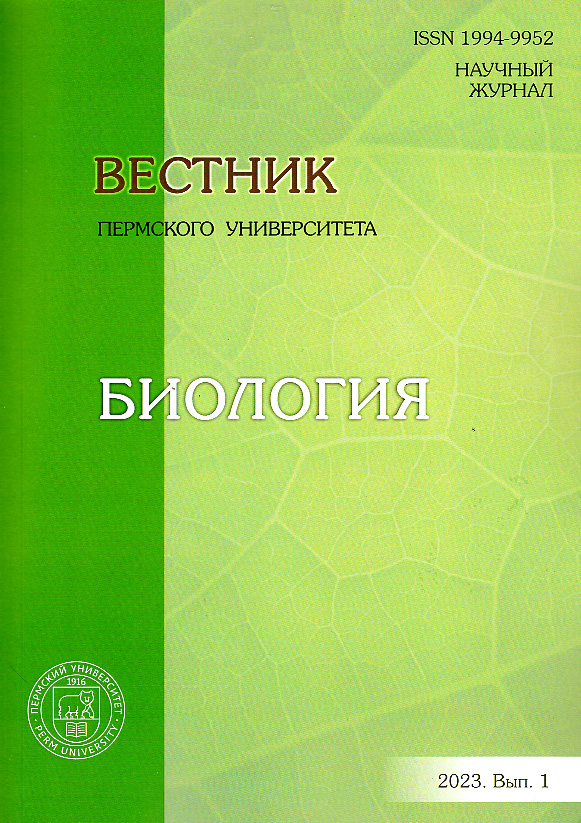Molecular genetic analysis for Fusarium species diversity in the winter triticale (×Triticosecale Wittm. ex A. Camus)
Main Article Content
Abstract
Article Details
References
Гагкаева Т.Ю. Классификация грибов рода Fusarium – дискуссия длительностью в двести лет // Микология сегодня. 2011. Т. 2. С. 14–39.
Гагкаева Т.Ю., Гаврилова О.П., Левитин M.М. Биоразнообразие и ареалы основных токсинопродуцирующих грибов рода Fusarium // Биосфера. 2014. T. 6, №1. С. 36–45.
Гагкаева Т.Ю., Гаврилова О.П., Орина А.С. Первое обнаружение гриба Fusarium globosum в микобиоте зерновых культур на территории Урала и Сибири // Вестник защиты растений. 2019. Т. 1, № 99. С. 10–18.
Гагкаева Т.Ю. и др. Фузариоз зерновых культур // Защита и карантин растений. 2011. № 5. С. 69–120.
Глинушкин А.П., Овсянкина А.В., Кисилева М.И. Видовой состав грибов из рода Fusarium на посевах ярового ячменя в центральной части России в 2015–2017 гг. // Российская сельскохозяйственная наука. 2018. № 5. С. 41–46.
Дубровская Н.Н. Эффективность фунгицидов в отношении возбудителя фузариозных заболеваний зерновых культур-гриба Fusarium proliferatum // The Scientific Heritage. 2020. Т. 50, № 1. С. 3–4.
Стахеев А.А. и др. Молекулярно-генетические методы в исследовании таксономии и специфической идентификации токсинпродуцирующих грибов рода Fusarium: успехи и проблемы // Сельскохозяйственная биология. 2016. Т. 51, № 3. С. 275–284.
Хасанов Б.А. Фузариозный вилт хлопчатника и современные методы идентификации грибов рода Fusarium. Ташкент, 2017. 135 с.
Якуба Г.В., Мищенко И.Г. Распространение грибов рода Fusarium на плодовых культурах юга России // Плодоводство и ягодоводство России. 2019. Т. 58, № 1. С. 206–211.
Abdel-Azeem A. et al. Fusarium: Biodiversity, Ecological Significances, and Industrial Applications // Recent Advancement in White Biotechnology Through Fungi. 2019. P. 201–261.
Bernal-Martínez L.et al. Detection of invasive infection caused by Fusarium solani and non-Fusarium solani species using a duplex quantitative PCR-based assay in a murine model of fusariosis // Med. Mycol. 2012. Vol. 50, № 3. P. 270–275.
Bubici G. et al. Biological Control Agents Against Fusarium Wilt of Banana // Front Microbiol. 2019. Vol. 10.
Burgess L.W., Bryden W.L. Fusarium: a ubiquitous fungus of global significance // Microbiology Austral-ia. 2012. Vol. 33, № 1. P. 22.
Chekali S. et al. Effects of Fusarium culmorum and water stress on durum wheat in Tunisia // Crop Protection. 2011. Vol. 30, № 6. P. 718–725.
Gräfenhan T. et al. An overview of the taxonomy, phylogeny, and typification of nectriaceous fungi in Cosmospora, Acremonium, Fusarium, Stilbella, and Volutella // Stud. Mycol. 2011. Vol. 68. P. 79–113.
Islam M.N. et al. Naturally Occurring Fusarium Species and Mycotoxins in Oat Grains from Manitoba, Canada // Toxins. 2021. Vol. 13, № 9. P. 670.
Ji F. et al. Occurrence, toxicity, production and detection of Fusarium mycotoxin: A review // Food Production, Processing and Nutrition. 2019. Vol. 1, № 1. P. 1–14.
Leslie J., Summerell B., Bullock S. The Fusarium Laboratory Manual. Hoboken: John Wiley & Sons, 2006.
Moretti A. Taxonomy of Fusarium genus: A continuous fight between lumpers and splitters // Zbornik Matice srpske za prirodne nauke. 2009. № 117. P. 7–13.
Nelson P., Dignani M., Anaissie E. Taxonomy, biology, and clinical aspects of Fusarium species // Clin. Microbiol. Rev. 1994. Vol. 7, № 4.P. 479–504.
Okungbowa F.I., Shittu H.O. Fusarium wilts: An overview // Environmental Research Journal. 2012. Vol. 6, № 2. P. 83–102.
Summerell B. Resolving Fusarium: Current Status of the Genus // Annu Rev. Phytopathol. 2019. Vol. 57, № 1. P. 323–339.
Suproniene S. et al. Distribution of trichothecene and zearalenone producing Fusarium species in grain of different cereal species and cultivars grown under organic farming conditions in Lithuania // Ann. Agric. Envi-ron. Med. 2010. Vol. 17, № 1. P. 79–86.
Zhao B. et al. Phylogeny and pathogenicity of Fusarium spp. isolated from greenhouse melon soil in Liaoning Province // Saudi Journal of Biological Sciences. 2014. Vol. 21, № 4. P. 374–379.




